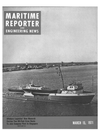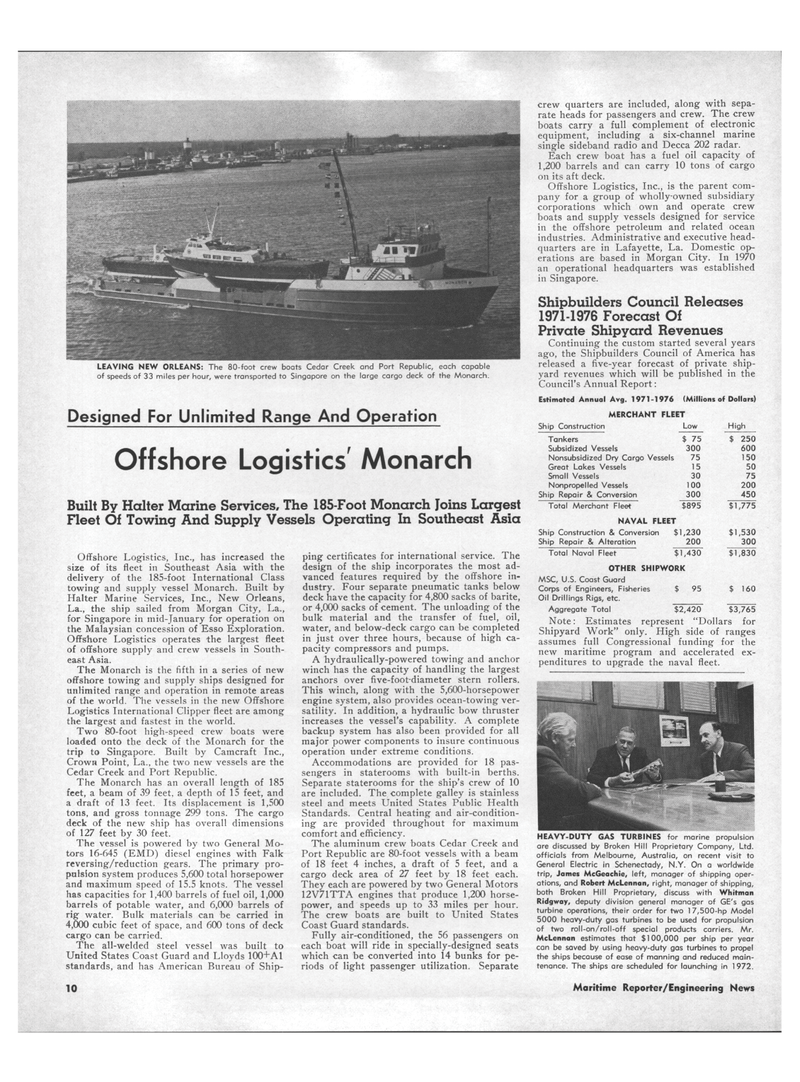
Page 8: of Maritime Reporter Magazine (March 15, 1971)
Read this page in Pdf, Flash or Html5 edition of March 15, 1971 Maritime Reporter Magazine
LEAVING NEW ORLEANS: The 80-foot crew boats Cedar Creek and Port Republic, each capable of speeds of 33 miles per hour, were transported to Singapore on the large cargo deck of the Monarch.
Designed For Unlimited Range And Operation
Offshore Logistics' Monarch
Built By Halter Marine Services, The 185-Foot Monarch Joins Largest
Fleet Of Towing And Supply Vessels Operating In Southeast Asia
Offshore Logistics, Inc., has increased the size of its fleet in Southeast Asia with the delivery of the 185-foot International Class towing and supply vessel Monarch. Built by
Halter Marine Services, Inc., New Orleans,
La., the ship sailed from Morgan City, La., for Singapore in mid-January for operation on the Malaysian concession of Esso Exploration.
Offshore Logistics operates the largest fleet of offshore supply and crew vessels in South- east Asia.
The Monarch is the fifth in a series of new offshore towing and supply ships designed for unlimited range and operation in remote areas of the world. The vessels in the new Offshore
Logistics International Clipper fleet are among the largest and fastest in the world.
Two 80-foot high-speed crew boats were loaded onto the deck of the Monarch for the trip to Singapore. Built by Camcraft Inc.,
Crown Point, La., the two new vessels are the
Cedar Creek and Port Republic.
The Monarch has an overall length of 185 feet, a beam of 39 feet, a depth of 15 feet, and a draft of 13 feet. Its displacement is 1,500 tons, and gross tonnage 299 tons. The cargo deck of the new ship has overall dimensions of 127 feet by 30 feet.
The vessel is powered by two General Mo- tors 16-645 (EMD) diesel engines with Falk reversing/reduction gears. The primary pro- pulsion system produces 5,600 total horsepower and maximum speed of 15.5 knots. The vessel has capacities for 1,400 barrels of fuel oil, 1,000 barrels of potable water, and 6,000 barrels of rig water. Bulk materials can be carried in 4,000 cubic feet of space, and 600 tons of deck cargo can be carried.
The all-welded steel vessel was built to
United States Coast Guard and Lloyds 100+A1 standards, and has American Bureau of Ship- ping certificates for international service. The design of the ship incorporates the most ad- vanced features required by the offshore in- dustry. Four separate pneumatic tanks below deck have the capacity for 4,800 sacks of barite, or 4,000 sacks of cement. The unloading of the bulk material and the transfer of fuel, oil, water, and below-deck cargo can be completed in just over three hours, because of high ca- pacity compressors and pumps.
A hydraulically-powered towing and anchor winch has the capacity of handling the largest anchors over five-foot-diameter stern rollers.
This winch, along with the 5,600-horsepower engine system, also provides ocean-towing ver- satility. In addition, a hydraulic bow thruster increases the vessel's capability. A complete backup system has also been provided for all major power components to insure continuous operation under extreme conditions.
Accommodations are provided for 18 pas- sengers in staterooms with built-in berths.
Separate staterooms for the ship's crew of 10 are included. The complete galley is stainless steel and meets United States Public Health
Standards. Central heating and air-condition- ing are provided throughout for maximum comfort and efficiency.
The aluminum crew boats Cedar Creek and
Port Republic are 80-foot vessels with a beam of 18 feet 4 inches, a draft of 5 feet, and a cargo deck area of 27 feet by 18 feet each.
They each are powered by two General Motors 12V71TTA engines that produce 1,200 horse- power, and speeds up to 33 miles per hour.
The crew boats are built to United States
Coast Guard standards.
Fully air-conditioned, the 56 passengers on each boat will ride in specially-designed seats which can be converted into 14 bunks for pe- riods of light passenger utilization. Separate crew quarters are included, along with sepa- rate heads for passengers and crew. The crew boats carry a full complement of electronic equipment, including a six-channel marine single sideband radio and Decca 202 radar.
Each crew boat has a fuel oil capacity of 1,200 barrels and can carry 10 tons of cargo on its aft deck.
Offshore Logistics, Inc., is the parent com- pany for a group of wholly-owned subsidiary corporations which own and operate crew boats and supply vessels designed for service in the offshore petroleum and related ocean industries. Administrative and executive head- quarters are in Lafayette, La. Domestic op- erations are based in Morgan City. In 1970 an operational headquarters was established in Singapore.
Shipbuilders Council Releases 1971-1976 Forecast Of
Private Shipyard Revenues
Continuing the custom started several years ago, the Shipbuilders Council of America has released a five-year forecast of private ship- yard revenues which will be published in the
Council's Annual Report:
Estimated Annual Avg. 1971-1976 (Millions of Dollars)
MERCHANT FLEET
Ship Construction Low High
Tankers $ 75 $ 250
Subsidized Vessels 300 600
Nonsubsidized Dry Cargo Vessels 75 150
Great Lakes Vessels 15 50
Small Vessels 30 75
Nonpropelled Vessels 100 200
Ship Repair & Conversion 300 450
Total Merchant Fleet $895 $1,775
NAVAL FLEET
Ship Construction & Conversion $1,230 $1,530
Ship Repair & Alteration 200 300
Total Naval Fleet $1,430 $1,830
OTHER SHIPWORK
MSC, U.S. Coast Guard
Corps of Engineers, Fisheries $ 95 $ 160
Oil Drillings Rigs, etc.
Aggregate Total $2,420 $3,765
Note: Estimates represent "Dollars for
Shipyard Work" only. High side of ranges assumes full Congressional funding for the new maritime program and accelerated ex- penditures to upgrade the naval fleet.
HEAVY-DUTY GAS TURBINES for marine propulsion are discussed by Broken Hill Proprietary Company, Ltd. officials from Melbourne, Australia, on recent visit to
General Electric in Schenectady, N.Y. On a worldwide trip, James McGeachie, left, manager of shipping oper- ations, and Robert McLennan, right, manager of shipping, both Broken Hill Proprietary, discuss with Whitman
Ridgway, deputy division general manager of GE's gas turbine operations, their order for two 1 7,500-hp Model 5000 heavy-duty gas turbines to be used for propulsion of two roll-on/roll-off special products carriers. Mr.
McLennan estimates that $100,000 per ship per year can be saved by using heavy-duty gas turbines to propel the ships because of ease of manning and reduced main- tenance. The ships are scheduled for launching in 1972. 10 Maritime Reporter/Engineering News

 7
7

 9
9
